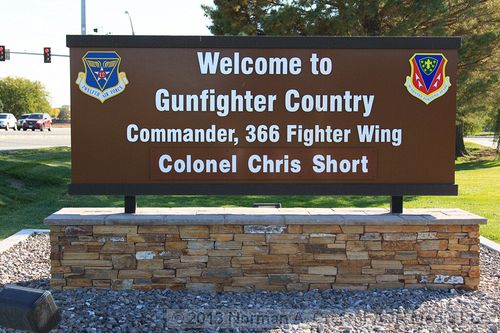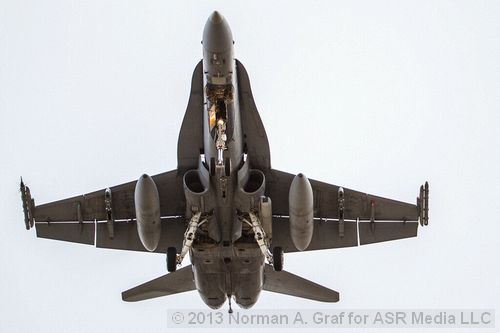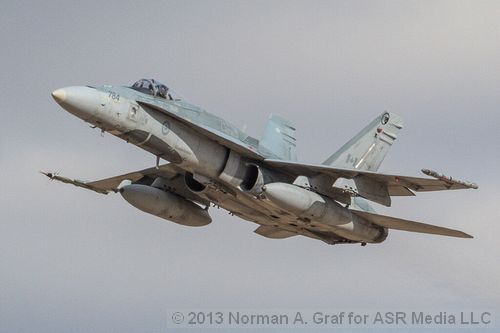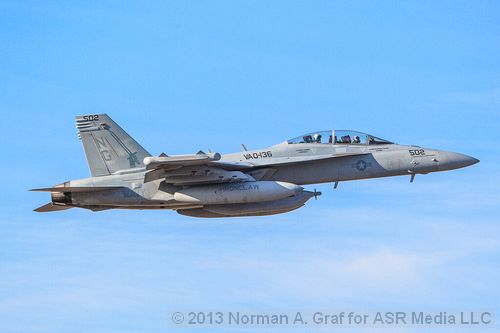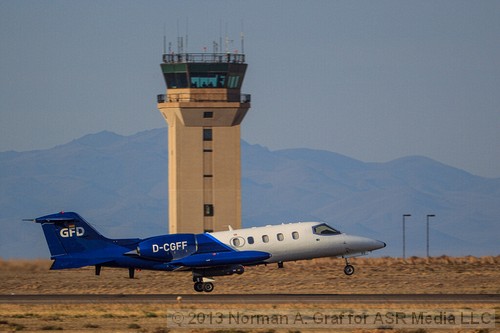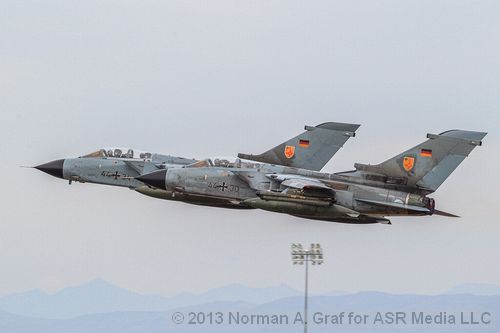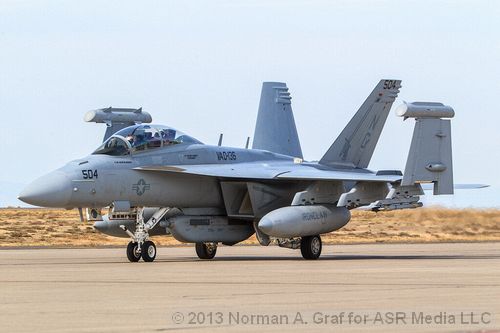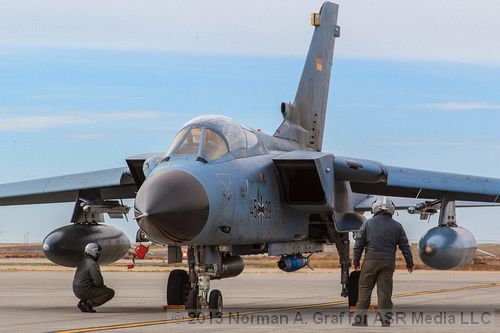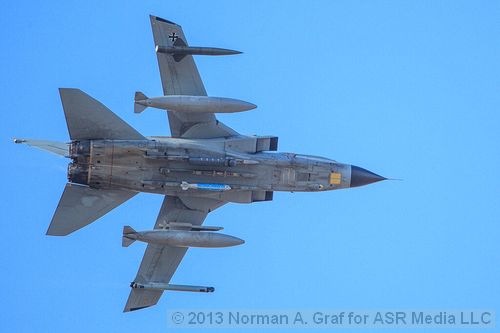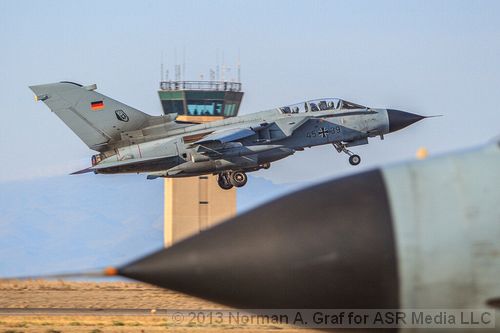 |
|
|
More than 300 German Air Force and Royal Canadian Air Force Airmen and nearly 300 visiting U.S. Sailors, Soldiers and Marines spent three weeks in the high desert of Idaho participating in a combined-joint exercise called Mountain Roundup 2013. This year marks the ninth time Mountain Home AFB has hosted this training exercise which features a broad spectrum of simulated missions. Access to over 7,500 square miles of modern, well-instrumented operational range space allows for realistic training while providing the flexibility to accommodate the complexity of this multinational, multiservice exercise. The exercise is part of the German Air Force (GAF) Tornado Fighter Weapons Instructor Course (FWIC) Mission Employment (ME) Phase and serves as the capstone of a multi-year curriculum. Earlier phases of instruction take place at Holloman AFB, NM, where German aviators typically spend seven months in FWIC training before they participate in Mountain Roundup to finalize their course. Evolving out of previous ME exercises at Nellis AFB, Mountain Roundup combines the best aspects of both Red Flag and Green Flag and features multiple air-to-air and air-to-ground missions such as basic fighter maneuvers, close-air support (CAS), urban combat support, suppression and destruction of enemy air defenses (SEAD/DEAD), and combat search and rescue (CSAR). Per the GAF: “According to its motto ''Sola Praecisio Valet'' (‘Only precision counts’) the FWIC trains highly skilled tactical leaders for the operational Tornado squadrons in Germany, who are able to solve unknown and complex problems with innovation and ingenuity, while teaching their peers how to apply the resulting solutions effectively and safely. This is achieved via a building block approach, starting with academic surface and aerial attack sorties, progressing into tactical missions, fighting surface and dissimilar air threats, while employing a wide range of non-precision, as well as laser guided live weapons.”
|
This year’s exercise was planned to be the largest to-date, with over 100 aircraft scheduled to participate. However, the government shutdown meant that many of the U.S. assets were grounded, including the host wing, the 391st Fighter Squadron (which did, however, conduct some missions on the final day of the exercise). The Idaho Air National Guard A-10s, stationed at Gowen Field in Boise, were similarly grounded. F-15C Eagles from the 125th Fighter Wing, Jacksonville Air National Guard Base, FL, which had already arrived to take part in the exercise, were forced to return home without participating and F-16 Fighting Falcons of the 64th Aggressor Squadron from Nellis AFB also did not participate because of the shutdown. This unfortunate circumstance, however, only added to the realism of the exercise, forcing ME planners to reshuffle assets just as they would in a real-life situation. Aircraft originally designated to be members of the Blue Team were reassigned to the Red Team, and missions were adapted to the new realities of the battlefield. |
The exercise focuses on integrating the disparate military forces into a cohesive team capable of conducting both offensive and defensive air and ground operations. Marine and Army elements deployed both day and night in convoys which were either the target of offensive operations or friendly forces which were being defended. Air resources deployed from a number of staging areas and converged over the Saylor Creek or Juniper Butte ranges. The first to take off were the KC-135 Stratotankers from Fairchild AFB, in Spokane, WA, and the KC-130 Hercules of VMGR-234 “Rangers,” staging out of Gowen Field in Boise. They were soon followed by the NATO E-3A AWACS which provided the “eyes in the sky” for the exercise. RCAF CF-188 Hornets from 409 Tactical Fighter Squadron and AV-8B Harriers of VMA-542 “Tigers,” departed from Gowen Field shortly thereafter. At Mountain Home AFB, ground crews were busy with their final preparations, loading munitions appropriate for the mission at hand. Soon the taxiways were crowded with a multitude of aircraft: Tornado GR-1s and GR-4s from the German Air Force, and F-15SG Strike Eagles from the Republic of Singapore Air Force, assigned to the 428th Fighter Squadron. Electronic warfare capabilities were provided by EA-18G Growlers from VAQ-136 "The Gauntlets," and “Jamkites,” modified Learjet 36As from the Gesellschaft für Flugzieldarstellung (GFD). On the ground, GAF joint terminal attack controllers (JTAC) along with JTACs from the U.S. Marine Corps 1st Air Naval Gunfire Liaison Company (ANGLICO) were embedded with the Army and Marine forces. They quickly established contact with their airborne assets and prepared for the exercise of the day. |
The high desert around Mountain Home resembles the landscape of southern and western Afghanistan and the huge expanses of restricted airspace and modern ranges provide a perfect training ground for the multinational forces. Instrumentation on the ranges allows ground threats to be electronically simulated and additional realism is provided by SMU-124E “Smokey Sams”. These simulator missiles provide a smoke trail in addition to the electronic signals, giving pilots in the air visual evidence of Surface to Air Missile (SAM) threats. Simulated targets, such as an airfield, an industrial complex, villages and radar, missile, gun and artillery sites allow highly realistic combat scenarios to be played out. |
Complex combined-forces exercises are played out day and night for two weeks. It is this ability to stage such large-scale composite air operations (COMAO) that makes Mountain Roundup the perfect capstone exercise for GAF Weapons Instructor Undergraduates (WUGs, pronounced “vooks”). The WUGs demonstrate proficiency as mission commanders by planning and executing five different Mission Employment (ME) tasks, including CSAR, CAS, SEAD/DEAD and SCAR (Strike Coordinated Attack and Reconnaissance). One day was devoted to planning, the next to executing the plan. “A mission commander needs to have a mastery of all of the weapons and delivery systems in the inventory. Each force brings different capabilities and Mountain Roundup, being a multinational Large Force Employment exercise, allows the students to assemble and deploy the best resources for each scenario, effectively integrating the Tornado into the highly complex COMAOs” said GAF Lieutenant Colonel Berg. Upon the successful completion of the course, the WUGs are promoted to Fighter Weapons Instructor Graduates. “The end result of this exercise is a collection of warfighters from multiple nations and branches of services that are significantly more prepared to engage in coalition major combat operations,” said U.S. Air Force Major Tapan Sen, 366th Fighter Wing Weapons and Tactics Flight Commander. Despite the disruptions caused by the government shutdown, everyone involved agreed that the mission had been accomplished. |
ASR was privileged to spend a whole day on base during Mountain Roundup 2013, watching both the departures and returns of the morning and afternoon missions. It was a great experience seeing ground and aircrews from different countries engaged in such realistic training exercises. Due to schedule shifts in the GAF training programs the next Mountain Roundup will be conducted in the summer of 2015, with participation by the Eurofighter Typhoon and Electronic Combat and Reconnaissance (ECR) Tornados expected. We look forward to returning for an even bigger and better Mountain Roundup 2015. In the meantime, join us at Mountain Home AFB September 20-21, 2014 for the Gunfighter Skies Airshow! |
ASR Media would like to thank 2nd Lt. Rebecca Ennis, Chief of Outreach for the 366th Fighter Wing Public Affairs Office for arranging the media access and providing invaluable support during our visit. We would also like to thank Maj. Tapan Sen, 366th Fighter Wing Weapons and Tactics Flight Commander & LtCol Andreas Berg and Capt Carsten Lippisch, GAF, for providing additional information on the exercise. |
Participating aircraft included: |
- GR-4 Tornado,GAF Tactical Fighter Wing 33, Büchel AB, Germany
- GR-1 Tornado, GAF Flying Training Center, Holloman AFB
- Learjet 36A “Jamkite,” Gesellschaft für Flugzieldarstellung, Hohn, Germany
- NATO E-3A Sentry AWACS, NATO Air Base Geilenkirchen, Germany
- CF-188 Hornet, RCAF 409 Tactical Fighter Squadron, CFB Cold Lake, Canada
- EA-18G Growler, VAQ-136 "The Gauntlets," NAS Whidbey Island
- AV-8B Harrier, VMA-542 “Tigers,” MCAS Cherry Point
- KC-130 Hercules, VMGR-234 “Rangers,” NAS JRB Fort Worth
- F-15SG Strike Eagle, 428th Fighter Squadron, Mountain Home AFB, Republic of Singapore Air Force
|
|
Rating:
N/A not an airshow
|
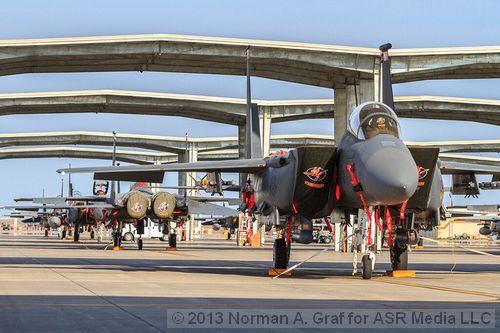 |
|
|
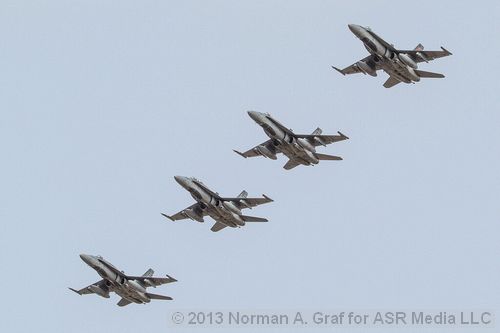 |
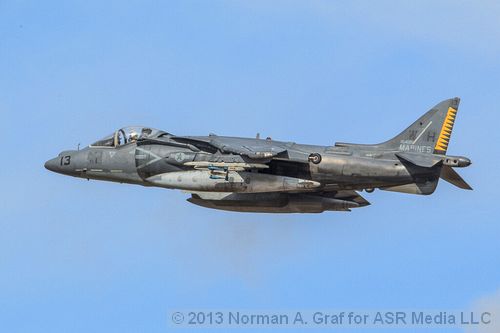 |
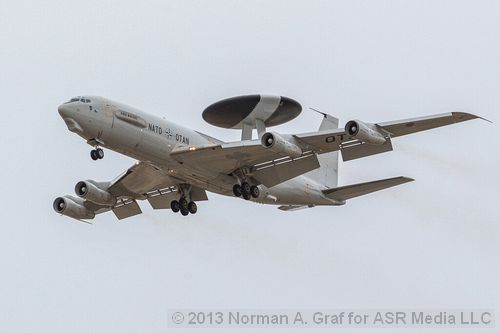 |
|
|
|
|
|
|
|
|
|
Review and photography by Norman A. Graf for ASR MEDIA LLC. |
|
|




